 | E-mail to Birds Korea |
 | KWBS |
in the Region
 | The Oriental Bird Club |
 | BirdLife International (Asia) |
September 30, Eocheong Island
Despite clear skies, a shift in the wind towards the west-northwest led to a good increase in the number of birds present, with best being more Chestnut-flanked White-eyes and a Hume's Leaf Warbler.
Seosan, September 29
Thick-billed Bean Goose: 20,000+, Swan Goose: 5 (A) 2 (J), Black-faced Spoonbill: 5, Yellow Wagtail: Many
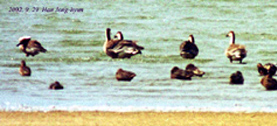

Eocheong Island, September 29
Highly changeable weather, with occasional showers and westerly winds, produced reasonable counts of Crested Honey Buzzard (over 100), along with Eochong's first autumn Black-backed Wagtail, Mugimaki Flycatcher and Black-faced Bunting (this and Chestnut Bunting are typically by far the commonest buntings in October). Additionally, the ca 28 Olive-backed Pipits logged suggest that this species' migration has finally started to get underway (the highest autumn day count in Korea was believed to be at least 1 000 on Gageo Island in mid-October 2000...).
Eocheong Island, September 28
Continuing mainly sunny skies and only 8 species of raptor, with Crested Honey Buzzard the most numerous. Other migrants included a small group of 7 White-throated Needletails, accompanied by a single late Pacific Swift, a single Blyth's Pipit, and Eocheong's first Black-browed Reed Warbler of the autumn. Close offshore, at least 415 Streaked Shearwaters were feeding around fishing boats.
Eocheong Island, September 27
With continuing light easterly winds and clear skies (poor for finding migrants on the Korean west coast) the approximately 600 Streaked Shearwaters, at present the highest count yet recorded from the ferry, provided one of the day's main highlights. Raptors and other migrants were moving in only small numbers on Eocheong Island itself.
Saemangeum, September 26
At Saemankeum (increasingly spelt Saemangeum) with only moderately high tides, 3 Spoon-billed Sandpipers (1 juvenile and 2 adults) early morning, and 4 Nordmann's Greenshank and 2 more Black-faced Spoonbill, accompanied by 1 White Spoonbill in the evening were obvious highlights, as was a Long-billed Dowitcher (ca the 4th record for Korea).
Visible passage along the northern edge of the Mangyeung River included ca 100 Barn Swallow past in an hour and large numbers of pipits on the move:
approximately 8 Richard's, 10 Olive-backeds, 5 Siberian Buff-bellied, 50+ Red-throated and 30+ Pechora Pipits were seen flying overhead. Sadly none showed well.
In addition 4 Crested Honey Buzzard, several Northern Hobby and the autumn's first Thick-billed Bean Goose also added diversity to the day's birding.
Yeongjong Island, September 25
Arriving from the US at Incheon airport at 1700 on the 25th with only an hour of light remaining, birding was limited, but species seen included Black-faced Spoonbill, with 12 (or 1.5% of the world population) present at one site.
Ami Mountain, Nakdong Estuary, Busan, September 24

Photos © Nial Moores
Again 12 species of raptor (including the autumn's first Merlin), and good numbers of White-throated Needletails (ca 115 in total moving southwest). Considered an uncommon passage migrant in Korea (Lee, Koo and Park, 2000), Needletails actually appear to be the commonest swift species by mid- September in South Korea, following the departure of most Pacific Swifts by late August.
Update: We've heard from an informed source that there have been no records of Rufous-bellied Woodpecker in North Korea for many years, thus confirming just how unusual was NM's sighting of one on Eochong Is, September 14th.
Ami Mountain, Nakdong Estuary, Busan, September 23
12 species of raptor, and ca 75 White-throated Needletails west during the day's watch, along with 2 Pechora and 3 Richard Pipits.
Bongrae Mountain, Busan, September 22
Needle tailed Swift: 34, Grey Streaked Flycatcher: 4, White's Thrush: 1
Ami Mountain, Nakdong Estuary, Busan, September 21
In increasingly overcast conditions, only 9 species of raptor (including a single Amur Falcon), 1 White-throated Needletail and 1 Asian House Martin were recorded. 3+ White's and 1 Siberian Thrush, along with Ashy Minivet and an unid'd very distant spoonbill sp. were the best non-raptors of the day.

Bongrae Mountain, Busan, September 20
White-throated Needletail: 42, Little Swift: 4, Grey streaked Flycatcher: 1
Bongrae Mountain, Busan, September 19
White-throated Needletail:66, Arctic Warbler:1
Bongrae Mountain, Busan, September 18
Little Swift:37, White-throated Needletail:66
Eocheong Island, September 17
Raptor passage somewhat stronger than at other times during the autumn so far (details will be released later as part of the National Institute of Environmental Research report), but outstanding highlight was the relocation of two white-eye flocks...Although highly mobile and rather elusive, the flocks contained at least 44 (and up to 65) White-eyes: 20-30 of those seen well enough were all Chestnut-flankeds (and no Japanese)! Other day highlights included a Siberian Thrush being chased by a Japanese Sparrowhawk and at least 215 Streaked Shearwatersfrom the ferry back to the mainland.
Eocheong Island, September 16

Some diurnal migration included nine species of raptor and ca 60 White-throated Needletailed Swifts. Most passerine species appeared to depart in largely clear conditions (with good visibility), but a flock of ca 40-60 white-eyes included at the very least 3 Chestnut-flanked White-eyes, assumed to be a very scarce migrant in South Korea.
Yasunori Nitani, of the Asian Raptor Migration Project 2002, has mailed to say that by 15th Sept over 30,000 Chinese Sparrowhawks had passed over the island of Teima Do/Tsushima (between Korea and Kyushu).
Bo-Shou Lin, of the Raptor Research Group of Taiwan, has passed on the following concise, and accurate, message re the Chinese Sparrowhawk passage there:
"Dear Friends, there are a HUGE number of Chinese [Goshawks] Sparrowhawks passing over Taiwan during these two days:
14th Sept: Taitung - 4065. Keng Ting - 1922.
15th Sept: Taitung - 44860, Keng Ting - 35355.
Taitung sits at the northeast of KengTing about 100 Km. The record of 9/15 was the highest amount till now in this season. It seems that the migratory peak of Chinese [Goshawk] Sparrowhawk had came to Taiwan."
For more information: Asian Raptor Migration Project 2002
On a related issue, it's worth noting that hunting of these raptors is rare in eastern Asia. One can only imagine the hail of gunfire that would meet the enormous flocks of these birds if they were unfortunate enough to migrate over Malta and other parts of Europe instead: see for instance the disgusting story at the Times of Malta website. (Thanks to Pete Revell)
Eocheong Island, September 16
Light rain and strong north-easterlies persisted most of the day, and little new of interest was found. Both the Tree Pipit (in the same fields as the autumn's first belated Olive-backed...) and the White-backed Woodpecker were still present, along with 2 Chestnut-cheeked Starlings, good numbers of grey and brown flycatchers and small numbers of other typical migrants (including single Black-capped Kingfisher, Broad-billed Roller, Pechora Pipit and Siberian Thrush).
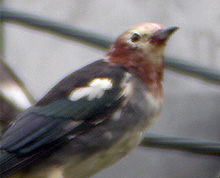
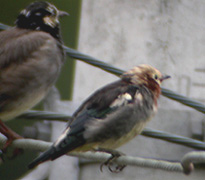
© Nial Moores
Eocheong Island, September 15
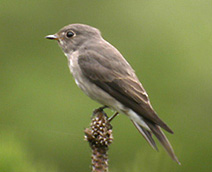
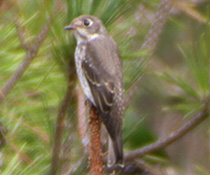
Grey-streaked Flycatcher
© Nial Moores.
With dull overcast conditions, good numbers of Arctic Warblers appeared to have arrived overnight. Also 5 species of flycatcher, including the autumn's first Red-throated and good numbers of Browns.
However, heavy rain with strengthening northeasterlies prevented much surveying. Bird of the day therefore was a Tree Pipit (the second of the autumn, and the seventh record for Korea, though still no Olive-backeds - easily Korea's commonest pipit species...).
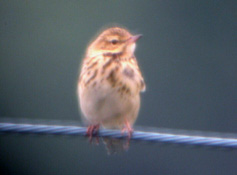
Seoul, September 15
Signs of a modest passerine migration visible in Seoul: Namsan held a couple of Arctic Warblers and Dark-sided Flycatchers, as well as some Blue-and-whites that are still around. There was also a small band of probably less than a half dozen Lanceolated Warblers (a common species in eg China's Happy Island, but scarce in southern parts of Korea) along the local river (2 seen, but there were others calling somewhere in the grass).
Eocheong Island, September 14
Generally overcast conditions with a light westerly, shifting to the northeast by evening, dropping in a fair range of migrants.
New autumn high counts of several species were reached, most especially Black-naped Oriole (25) and Chestnut Bunting (ca 15): the latter species peaks in mid-October. Best sight was 5 Broad-billed Roller hawking insects in the evening along with 1 Northern Hobby and 11 White-throated Needletails.
By far the rarest sighting was of a male Rufous-bellied Woodpecker Dendrocopos hyperthrus flying in off the sea in the late afternoon. Not uncommon on migration through China's Beidaihe and Happy Island, it is listed rather enigmatically by Lee, Koo and Park (2000) as a rare resident in North Korea.
Dr. Park Jin-Young suggests, however, that is has probably not been recorded in Korea (North or South) for a number of years. With the White-backed Woodpecker still present too, this means rather incredibly 2 dendrocopos species are now present on this far offshore island.
Bongrae Mountain (400m high), southeastern part of Pusan, September 13
In strong wind and drizzle, 2 White's Thrushes, 1 Dusky Warbler (which is not common in southern part of Korea, and +10 Yellow-throated Buntings.
Eocheong Island, September 13
Incredible visibility (> 150Km?) encouraged some diurnal migration, with a couple of Common Rosefinch and small numbers of Richard's and Pechora Pipits moving through, along with Eocheong Island's first autumn Ashy Minivet and Grey-faced Buzzard.
Increasing afternoon cloud then dropped a few migrants, but still presumably in smaller numbers than present these past few days on Gageo Island in the far southwest. Best species of the day were the White-backed Woodpecker again, 2 or 3 male Siberian Thrush and a Middendorf's Grasshopper Warbler, surprisingly the first for the island.
Eocheong Island, September 12
Continuing unseasonably hot weather and clear skies resulted in few grounded migrants. By far the most surprising sighting was of a juvenile White-backed Woodpecker, which apparently came in off the sea (the island is about 50km west of the mainland, though only 10km south of a chain of small uninhabited islands)...
First for the autumn species included Pallas's Leaf Warbler and Little Bunting, while the day's biggest "miss" was a probable immature Lesser Kestrel. Features well-seen in flight included a clear central tail protrusion (much more striking than typical on Northern Hobby for example), blunter looking primaries and a shorter 'hand', pale appearance overall (especially on the underwings) and very heavy streaking near-confined to the upper breast.
Gunsan-Eocheong Island, September 11
In clear conditions, few new birds on the island, with the day's highlights being 2 Finless Porpoise and 2 Short-tailed (Slender-billed) Shearwaters along with 104 Streaked Shearwaters seen from the ferry (feeding on enormous schools of small fish).
On Eocheong itself, several Pintail Snipe, 3 White-throated Needletails, and in the late evening 5 Northern Hobby feeding on dragon fly swarms were probably the most interesting.
In July, Jan Hein van Steenis, a Dutch birder, reporting sightings of Tristram's Bunting in Odae San Ntl Park in the Sorak Mountains. Would these be early migrants or breeding birds, he asked? Given the dates, the latter seemed possible...
Interestingly, then, news was recieved today of the following records published by the Korean National Parks Association (govt section):
Tristrams Buntings, and Pallas Leaf, Raddes, and Dusky Warblers, have all been found through the summer in the Sorak Mountain area, Kangwon province (NE region). This represents an extension of the previously listed summering range of all four species in to South Korea. ( Dr Park Jin-young pers comm.)
Exciting news too of another sensational breeding record: 5 pairs of Chinese Grey Shrike nested this year in Cheolwon - a remarkably high count, and also the first confirmed breeding records for the country (Dr Lee Ki-sup pers comm). Considered to be a rather scarce winter visitor to Korea, like the species above, this is another major extension of the previously known range.
Kim Su-kyung is taking part in a funded survey of migrating raptors, and is compiling data at Taejongdae, Korea's most south-westerly mainland headland: she reports that one flock of passing birds contained over 500 Chinese Sparrowhawks. Huge numbers of this raptor are known from Japan in autumn, and this first multi-observer survey will undoubtedly prove that many of the Japanese birds pass through the Korean peninsulafirst.
The survey is being co-ordinated by Dr Park Jin-young and organized by the National Institute of Environment Research (NIER),and aims to cover the period: 9 Sept to 30 Sept.
The survey is taking place at the following locations: Taejongdae in Pusan, Geoje Island, Gageo Island, Taehuksan Island, Eochong Island.
Researchers involved include: Park Jin Young (NIER); Kim Dong Hyun (Kyunghee Uni.)- Kageo Island, Taehuksan Island; Kim Su Kyung (Kyungpook Uni,. Birds Korea), Hurulu (Kyungpook Uni.) - Taejongdae; Nial Moores (Birds Korea) - Eocheong Island, Kageo Island (?); and Kim Tae jwa (Kyungnam Uni.), plus one other person - Geoje Island.
Survey data of course belongs to the NEIR, but Birds Korea is very grateful that an agreement has been reached that allows Nial and Su Kyung to forward data for use on this site.
Information will be posted as soon as it is recieved.
Mangyeung Estuary, Saemankeum, September 9 and 10
With good high tides in both the early morning and evening, excellent views were had of a large number of shorebirds coming into two separate roosts.
In total, no less than 34 species of shorebird were observed (with the addition of a 35th species, the Eastern Oystercatcher Haematopus [ostralegus] osculans at the neighboring Geum Estuary, topped, however, by 4 Black-faced Spoonbills).
Time was too limited to check much of the Mangyeung or even to visit the other half of the Saemankeum complex, the Dongjin estuary, which would no doubt have boosted diversity and numbers much further still....
Only incomplete counts were made due to grey hazy weather and the demands of filming: tough conditions as about 25 000 shorebirds came into one roost, with a further 28 000-30 000 into the second one!
Species highlights included:
Broad-billed Sandpiper: At least 170.
Ringed Plover: 1 ( a rather scarce migrant in South Korea, recorded less than 3-5 times annually)
Nordmann's (Spotted) Greenshank: 1 + 4 (probably rather more were present...)
Great Knot: at least 21 000 total
Little Stint: 1 juvenile (recorded near-annually: at least three individuals recorded in the Saemankeum region this year, with 2 in the spring)
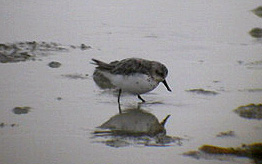
Spoon-billed Sandpiper: At least 15 on the 10th, made up of 1 juvenile and 14 adults (2 of which were still in near full-breeding plumage...). Probably several at least were overlooked, as the "four-red-flagged" bird found by Kim Kyung-Won and Dr. Lee Ki-Sup on the 9th was looked for but could not be relocated.
Amongst three Australian leg flag sightings, most interesting was probably a Red-necked Stint flagged in Southeast Australia. More details will be posted later in the Flagging/Banding section.
Okku, September 9
Shorebirds at Okku included 3 Spoon-billed Sandpipers, all adults, one of which was carrying FOUR red leg-flags (two on each leg).
Such a combination is unknown to us at the moment, but once we find out more details of this bird we'll post the information.
Eocheong Island, September 4
Limited surveying in dense patchy fog before the boat back to the mainland produced the autumn's first Dusky Warbler and more surprisingly a Tree Pipit . This species, first recorded in Korea on Gageo Island in 2000, might well turn out to be a scarce but regular migrant, with a total of 5 further records involving 6 individuals, all on Gageo and Eocheong Island.
Eocheong Island, September 3
With the island shrouded in dense fog there were few additional birds, though at least 4 Pechora Pipits, 3 Forest Wagtails, 1 Lanceolatedand 1 Pleske's (Styan's) Grasshopper Warbler were recorded.
Eocheong Island, September 2
A general improvement in the number of migrants, with 46 species recorded, though no starlings. Highlights included an apparent Long-eared Owl (considered a scarce winter visitor to Korea) and a Thick-billed Warbler. Although considered the most numerousAcrocephalus on Happy Island at this period (e.g. Dierschke and Heintzenberg unpublished report in 1994) this was perhaps only the third found in South Korea in recent years.
Eocheong Island, September 1
Typhoon Rusa cleared the area at around 0800, followed by blue sky and a strengthening west wind. Small numbers of migrants began to drop in through the afternoon including an Eastern Marsh Harrier , 4 Common Rosefinch and most surprisingly a juvenile Rose-colored Starling, a first for Korea. Full details have been posted on our Rarity reports page.
Birds Korea 1108 Ho, 3 Dong, Samick Tower Apt., 148-22, Namcheon-Dong, Su-Young-Gu
Busan, 618-762 Republic of Korea





